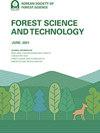Spatial analysis of landscape rehabilitation in degraded land along topographic variabilities in the Kiliso sub-watershed, Southern Ethiopia
IF 2.2
Q2 FORESTRY
引用次数: 0
Abstract
Abstract In Ethiopia, particularly in Southern Oromia and Eastern Halaba, land degradation is a common challenge for the pastoral community and farmers. As a result, the sub-watershed has closed for the past five years. However, little is known about the effects of topography on the rehabilitation of various land uses and land covers (LULCs). This study determined how the main topographic variables affect the rate of rehabilitation. Sentinel-2 images were used to quantify land use and land cover for the years 2017 and 2021. The aspect, altitude, and slope were calculated using the SRTM of 1 Arc-Second Global. The Maximum Likelihood classifier algorithm was used for supervised image classification. Changes in LULCs were analyzed using the post-classification technique. The LULC maps were overlaid with the topographic variabilities. The topographic variability’s influences were clearly observed on the rehabilitation rate of area enclosure. In the slope class of 0 to 5%, agriculture is the dominant cover. The bushland was largely detected in the slope classes of 0 to 10 in 2017. Agriculture and barren land were influenced as altitude and slope increased. Forest and bushland were found to be highly restored at an altitude of 1841 to 1880, an aspect of the south, and slope classes of 0 to 5 percent.埃塞俄比亚南部Kiliso小流域退化土地景观恢复的地形变化空间分析
在埃塞俄比亚,特别是在南奥罗米亚和东哈拉巴,土地退化是牧区和农民面临的共同挑战。因此,该小流域在过去5年里一直处于关闭状态。然而,关于地形对各种土地利用和土地覆盖(lulc)恢复的影响知之甚少。本研究确定了主要地形变量如何影响康复率。哨兵2号图像用于量化2017年和2021年的土地利用和土地覆盖。利用1 Arc-Second Global的SRTM计算坡向、海拔和坡度。采用最大似然分类器算法对图像进行监督分类。使用后分类技术分析lulc的变化。LULC地图与地形变化叠加。地形变异性对封地恢复率的影响较为明显。在坡度为0 - 5%的范围内,农业是主要的覆盖。2017年,灌木林主要分布在坡度0 ~ 10级。随着海拔和坡度的增加,农业和荒地受到影响。在1841年至1880年的海拔高度,森林和灌木林得到了高度恢复,这是南方的一个方面,坡度为0%至5%。
本文章由计算机程序翻译,如有差异,请以英文原文为准。
求助全文
约1分钟内获得全文
求助全文

 求助内容:
求助内容: 应助结果提醒方式:
应助结果提醒方式:


